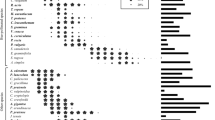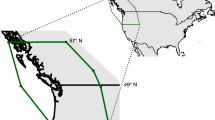Abstract
In this paper, we test the mid-domain hypothesis as an explanation for observed patterns of flowering diversity in two sub-alpine communities of insect-pollinated plants. Observed species richness patterns showed an early-season increase in richness, a mid-season peak, and a late-season decrease. We show that a “mid-domain” null model can qualitatively match this pattern of flowering species richness, with R2 values typically greater than 60%. We find significant or marginally significant departures from expected patterns of diversity for only 3 out of 12 year-site combinations. On the other hand, we do find a consistent pattern of departure when comparing observed versus null-model predicted flowering diversity averaged across years. Our results therefore support the hypothesis that ecological factors shape patterns of flowering phenology, but that the strength or nature of these environmental forcings may differ between years or the two habitats we studied, or may depend on species-specific characteristics of these plant communities. We conclude that mid-domain null models provide an important baseline from which to test departure of expected patterns of flowering diversity across temporal domains. Geometric constraints should be included first in the list of factors that drive seasonal patterns of flowering diversity.



Similar content being viewed by others

References
Ashton PS, Givnish TJ, Appanah S (1988) Staggered flowering in the Dipterocarpaceae: new insights into floral induction and the evolution of mast fruiting in the aseasonal tropics. Am Nat 105:44–66
Cole BJ (1981) Overlap, regularity, and flowering phenologies. Am Nat 117:993–997
Colwell RK, Hurtt GC (1994) Nonbiological gradients in species richness and a spurious rapoport effect. Am Nat 144:570–595
Colwell RK, Lees DC (2000) The mid-domain effect: geometric constraints on the geography of species richness. Trends Ecol Evol 15:70–76
Colwell RK, Rahbek C, Gotelli NJ (2004) The mid-domain effect and species richness patterns: what have we learned so far?. Am Nat 163:E1–E23
Fleming TH, Partridge BL (1984) On the analysis of phenological overlap. Oecologia 62:344–350
Gillooly JF, Brown JH, West GB, Savage VM, Charnov EL (2001) Effects of size and temperature on metabolic rate. Science 293:2248–2251
Gotelli NJ, Graves GR (1996) Null models in ecology. Smithsonian Institution, Washington
Hawkins BA, Diniz-Filoh JAF (2002) The mid-domain effect can not explain the diversity gradient of Nearctic birds. Global Ecol Biogeogr 11:419–426
Inouye DW (2000) The ecological and evolutionary significance of frost in the context of climate change. Ecol Lett 3:457–463
Inouye DW, McGuire AD (1991) Effects of snowpack on timing and abundance of flowering in Delphinium nelsonii (Ranunculaceae): implications for climate change. Am J Bot 78:997–1001
Inouye DW, Morales MA, Dodge G (2002) Variation in timing and abundance of flowering by Delphinium barbeyi Huth (Ranunculaceae): the roles of snowpack, frost, and La Niña, in the context of climate change. Oecologia 130:543–550
Inouye DW, Saavedra F, Lee-Yang W (2004) Environmental influences on the phenology and abundance of flowering by Androsace septentrionalis L. (Primulaceae). Am J Bot (in press)
Jetz W, Rahbek C (2001) Geometric constraints explain much of the species richness pattern in African birds. Proc Natl Acad Sci USA 98:5661–5666
Jetz W, Rahbek C (2002) Geographic range size and determinants of avian species richness. Science 297:1548–1551
Lees DC, Kremen C, Andriamampianina L (1999) A null model for species richness gradients: bounded range overlap of butterflies and other rainforest endemics in Madagascar. Biol J Linn Soc 67:529–584
NCDC (2003) U.S. climate normals: daily station normals 1971–2000 (CLIM84). http://www5.ncdc.noaa.gov/climatenormals/clim84/CO/CO051959.txt
Pleasants JM, Rathcke B, Lacey EP (1990) Null model tests for competitive displacement: the fallacy of not focusing on the whole community. Ecology 71:1078–1084
Rathcke B (1988) Flowering phenologies in a shrub community: competition and constraints. J Ecol 76:975–994
Rathcke B, Lacey EP (1985) Phenological patterns of terrestrial plants. Annu Rev Ecol Syst 16:179–214
Saavedra F, Inouye DW, Price MV, Harte J (2003) Changes in flowering and abundance of Delphinium nuttallianum (Ranunculaceae) in response to a subalpine climate warming experiment. Global Change Biol 9: 885–894
Veech JA (2000) A null model for detecting nonrandom patterns of species richness along spatial gradients. Ecology 81:1143–1149
Waser NM (1978) Competition for hummingbird pollination and sequential flowering in two Colorado wildflowers. Ecology 59:934–944
Willig MR, Lyons SK (1998) An analytical model of latitudinal gradients of species richness with an empirical test for marsupials and bats in the New World. Oikos 81:93–98
Acknowledgements
We thank the Rocky Mountain Biological Laboratory and John Tuttle for providing access to study sites, and Rob Colwell, Bill Fagan, and Justin Calabrese for comments on earlier drafts of this paper. This material is based upon work supported by the National Science Foundation under grants DEB 94-08382, IBN-98-14509, and DEB-0238331 to D.W.I., and by assistance from Earthwatch and its Research Corps.
Author information
Authors and Affiliations
Corresponding author
Rights and permissions
About this article
Cite this article
Morales, M.A., Dodge, G.J. & Inouye, D.W. A phenological mid-domain effect in flowering diversity. Oecologia 142, 83–89 (2005). https://doi.org/10.1007/s00442-004-1694-0
Received:
Accepted:
Published:
Issue Date:
DOI: https://doi.org/10.1007/s00442-004-1694-0



